Article
Crieff, Perthshire 2: Scotland's Gateway to the Highlands
Author(s):
Crieff was famous in the 1700s for its October Tryst when cattlemen from all over the Highlands of Scotland came south to this market town to sell their cattle. Today the visitors come for different reasons, such as touring the distillery and visiting historic castles.
Crieff was famous in the 1700s for its October Tryst when cattlemen from all over the Highlands of Scotland came south to this market town to sell their cattle. The celebrations that followed the cattle drive’s success made the town wild as if Crieff briefly became the Dodge City of Perthshire. The town’s population has been static at 6,000 for many decades but records from 1790 show it was 1,200 at that time with “ten cows per person.”
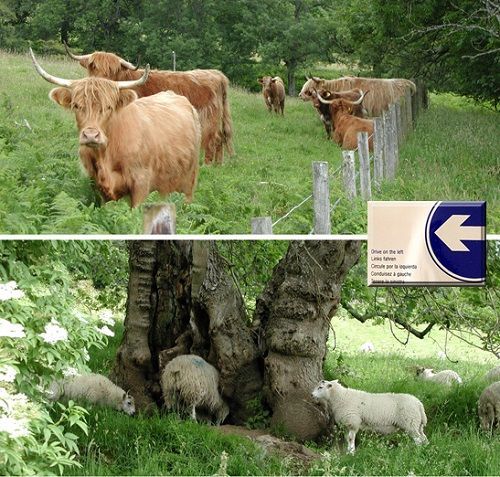
Walking all over Crieff shows you a town’s history but you really need a car to explore the countryside. When we rent a car from Auto Europe to drive Scotland, we are pleased to get its dash sticker in five languages to remind us to “Drive on the Left.” We always chant that to ourselves for the first few days—but that’s another story! You will have no trouble seeing 2 of Scotland’s assets, its Highland Cattle and its sheep—sometimes wandering a country lane right in front of you.
Favorite Places
Heading South
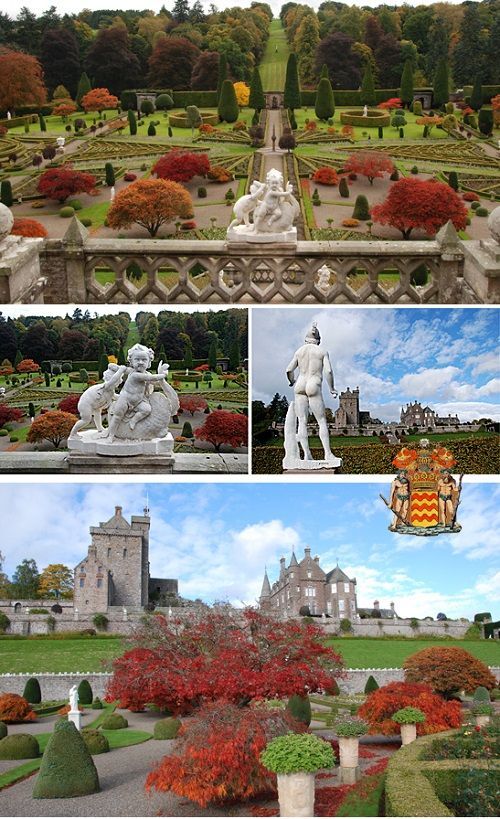
Drummond Castle and its Gardens (which were shown in such glory in a scene from the 1995 movie Rob Roy) lies 2 miles south of Crieff on the road to the village of Muthill. The gorgeous gardens were created in 1630 and are an unexpected delight in what is really an inconsequential Scottish village. Historic Scotland calls them “the best example of formal terraced gardens in Scotland.”
Heading North and East
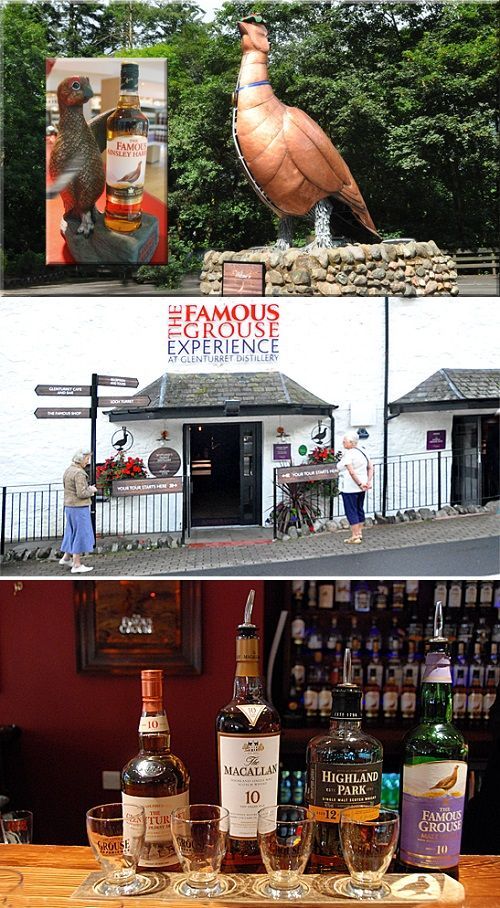
A mile west along the A.85 where it continues on 5 miles away to Comrie, a side road north along the Barvick Burn leads to the Glenturret Distillery, established in 1775 by a crowd of smugglers and thus one of the oldest in Scotland. Its visitor center was inaugurated in 2002.
Whereas the distillery remains a popular and satisfactory tourist attraction and most visitors then return to Crieff, for me continuing on east about 3 more miles to Monzie is a more personal experience. Rover Scouts held their Third International Moot in the fields surrounding that village in 1939 as if in defiance of the war clouds scudding over Europe, Thirty-six hundred senior Boy Scouts came from 42 lands in October that year, says the Boy’s Life magazine, to enjoy “the fickle weather of a Scottish summer.” I return there each visit to Crieff to recall the memory I have of walking as a small boy past all the smiling faces amongst the wet tents and seemingly bottomless puddles in the fields.
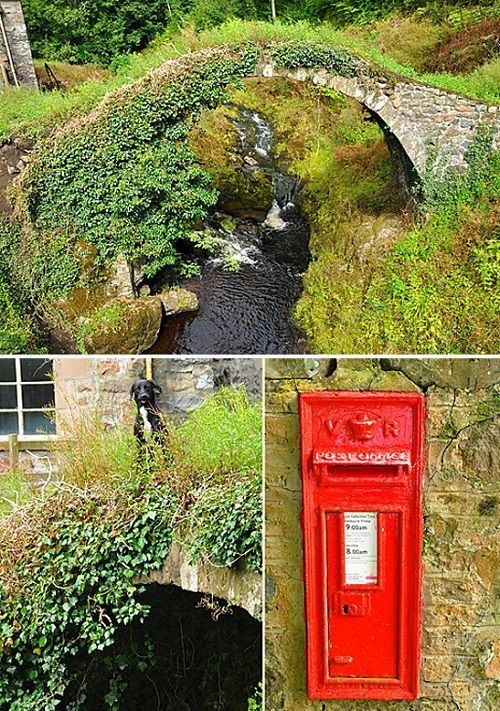
But I go this way to marvel how far north the Romans managed to get in this country where they were so opposed by the Picts. The “Roman” Bridge over the Shaggie Burn at Monzie may not in fact be Roman. On the day of my photograph it seemed guarded only by a friendly Black Lab. Across from the bridge a currently used mail box on a wall shows the frugality of the Scots: Originally installed in the reign of Queen Victoria it should have been replaced with each new monarch but Scottish institutions do like to save money.
Heading East
A drive 2 miles or so farther down to Gilmerton village on the Perth Road gives you a chance to go 3 more miles to Fowlis Wester, again one of my favorite places to visit. This little group of about 2 dozen homes with its ancient St. Bean’s Church lies about 4 miles east of Crieff on the road to Perth, (with a population of almost 150,000 the largest city in Perthshire). St. Bean’s is worth a visit. The Pictish slab-cross now inside goes back to the 8th or 9th century; the one standing on the village green is now a replica. The church has been restored but it goes back to the AD1200s at a time when leprosy was common and feared so much it had a “leper’s window” where the ostracized lepers outside could, in a way, partake of the service without putting the congregation at risk. (Our 2012 visit to the Bergen Hansen Leprosy Museum in Norway can be read here.)
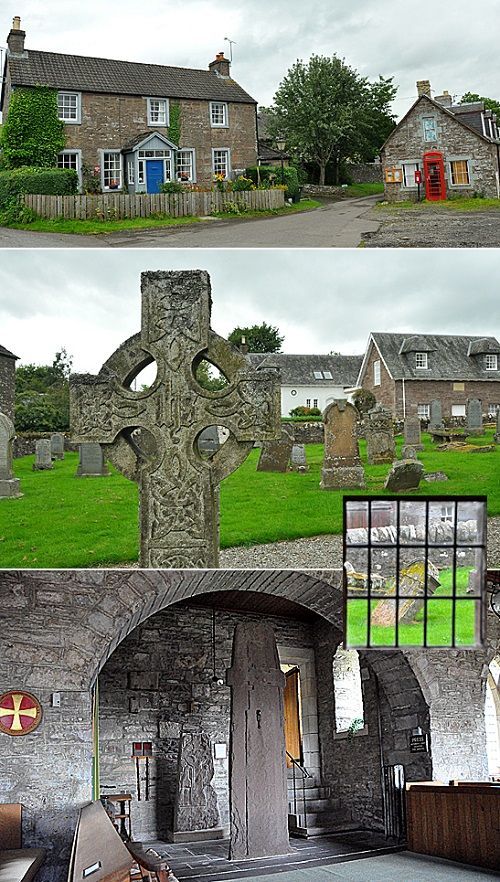
The village green. St. Bean’s Church with leper’s window (insert.) Pictish Cross inside church dates back to 8th or 9th century.
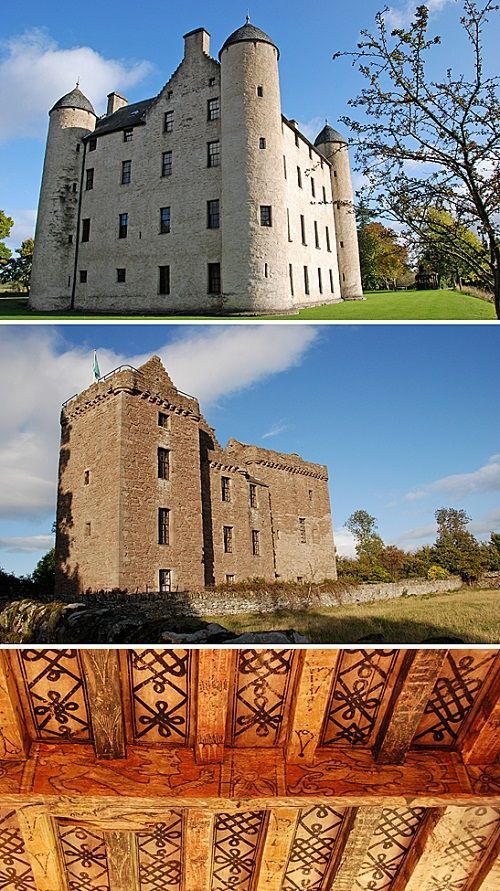
Driving east from this point, the 15 or so more miles, to Perth, the largest city in Perthshire, is worth doing. The Perth Road runs past a building high up on the left, Methven Castle, that is really a private residence, and a few miles farther on also on the left as you approach Perth, a building called Huntingtower that is really a castle.
Huntingtower Castle is an interesting stop, especially if your time is limited, because it lacks furnishings so you don’t have to gape at the Martha Stewart equivalents of the 16th century which makes for a quick visit. Why stop? Well it has for visitors the charms of its fine painted ceiling and then its history. Mary Queen of Scots had her honeymoon here in 1582. After her forced abdication her son became King James VI at the age of 13 months. Regents and advisors conspired to usurp the royal power and for 13 months the infant was imprisoned by the Ruthven family who owned this castle. When the king came of age both Earls who had arranged his imprisonment were executed. The castle history includes the “Maiden’s Leap.”
The maiden was Dorothea, the daughter of the first Earl of Gowrie, her lover one John Wemyss, a visiting guest accommodated in the adjacent tower 10 feet from her bedroom’s tower. The mother, informed by a servant that the pair were in the guest’s bedroom, angry and suspicious went up the stairs. The daughter heard her coming and supposedly jumped the almost 10-foot gap between the towers to get back to her own bedroom in time. The details of this legend are evasive and the dates unclear although the couple is said to have eloped the next day.
If you have plenty time stop at the hotel and restaurant of the same name nearby. I have dined in the restaurant several times and feel the hotel would be an excellent upscale choice if you wanted to explore Perth the next day.

The Perth Museum and Art Gallery has generous benefactors so admission is free. There is no museum parking but street parking can be convenient. Museum exhibits include Raeburn portraits, McCulloch landscapes, Ramsay silver and Malone vases. And portraits of, as always, pompous town officials and models of sailing ships and gold cases and innovative weighing machines and examples of scientific instruments.
The museum based on the Pantheon in Rome was extended in 1935 with a Royal Opening where the Duke of York, the future King George VI, decided he would wear the kilt. Consternation! He would be sitting on an elevated dais facing the public. A screen was quickly arranged to screen part of the royal presence!
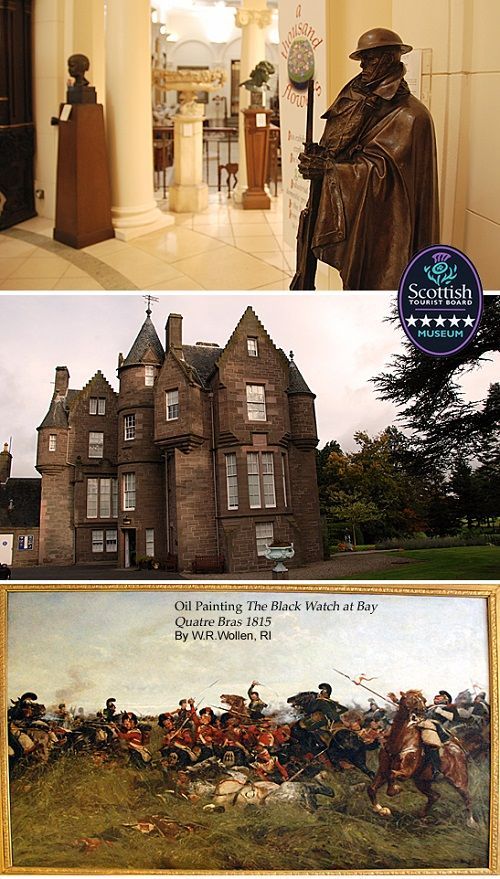
The entrance to the Perth Museum reminds visitors that a large part of recent Perth history includes the two World wars that almost destroyed Europe. The local Highland regiment is the Black Watch and it has its own regimental museum in Perth on Hay Street at Balhousie Castle. It lies about half a mile to the northwest of the Perth Museum and an easy walk with easier parking.
The Black Watch was raised after the 1715 Jacobite rebellion as a regiment created from 4 clans loyal to the crown. (The Jacobites were Highlanders favoring the exiled king-pretender James and hoping, with French Catholic support, to put him on the Scottish throne.) The regimental tartan was so dark it was almost Black; its task to Watch the highlands, hence its name.
One of the regiment’s many battles was 2 days before Waterloo in 1815 at the village of Quatre Bras where they were attacked by French cavalry before they could form the traditional square with fixed bayonets that could repulse a cavalry attack—but still they held.
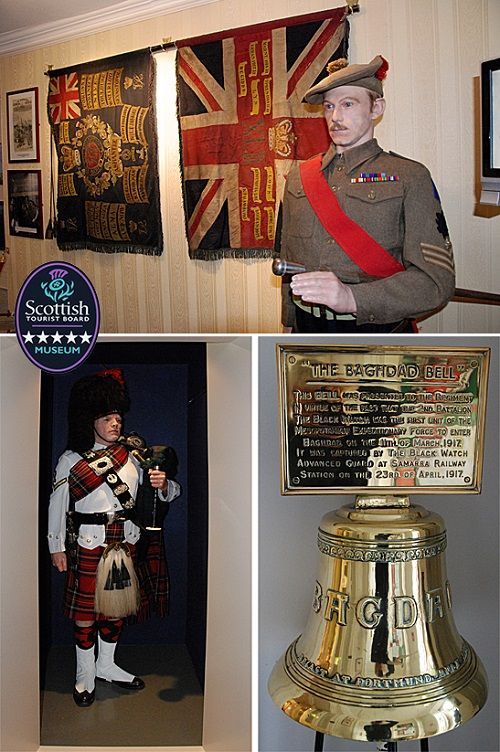
The awards given a regiment attest to how often and in how many far-off places a regiment fought for its country. Yet the pride of achievement must sometimes ring hollow at the futility of war. Here for example stands the Bagdad Bell, a 1917 relic from the 2nd Battalion’s battles in Mesopotamia. “War is what happens when politicians run out of ideas,” the saying goes.
Well, if you’re in the city of Perth (and are not interested in salmon fishing on its famous River Tay) and you have a car, you don’t need to run out of ideas. You can head north the mere 3 miles from Perth to the site of the coronations of the Kings of Scotland, Scone Palace—and that leads to our next story.
Photography by the author
The Andersons, who live in San Diego, are the resident travel & cruise columnists for Physician's Money Digest. Nancy is a former nursing educator, Eric a retired MD. The one-time president of the New Hampshire Academy of Family Physicians. Eric is the only physician in the Society of American Travel Writers. He has also written 5 books, the last called The Man Who Cried Orange: Stories from a Doctor's Life.




